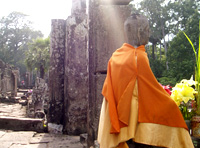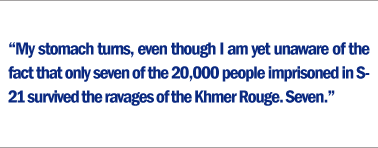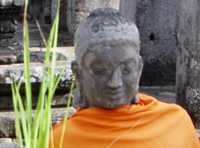
We climb into the back of a tuk-tuk, half
awake and stumbling in the darkness before
setting off through the blanket of ever-increasing
humidity towards Angkor. The sky is a
black velvet midnight even though dawn
is just an hour away. As we rumble along
the wide, tree-lined road into the park
of ancient cities, the screech of geckos
and symphony of cicadas are drowned out
by the protesting rattle of our moto.
I close my eyes- a reprieve from the endless
storm of dirt and dust rising from the
old and decrepit road- and a warm wind
wraps me in its soft embrace, bringing
with it the intoxicating scent of Cambodia
in the morning: sweet lotus blossoms,
jasmine, incense.
The
tuk-tuk rounds the last bend in the
road as the sky begins to gradually
fade, revealing the dark, imposing profile
of Angkor Wat. The sun rises slowly,
and as the sky gradually melts from
black to shimmering translucent silver,
the Wat is transformed into a magical
kingdom of muted, stormy beach colours.
We
climb to the top spire and wander through
lonely monochromatic corridors of rain-beaten
and stained sandstone columns before
settling into an archway facing East.
The inner courtyard is bathed in the
warm lazy half-light of early morning,
revealing the velvety blanket of green
moss, with its vibrant golden-yellow
undertones creeping up the ancient wall.
Cambodia is a kingdom that demands an
emotional response; it holds the best
and the worst of humanity within a country
smaller than Oklahoma. Its sheer beauty,
once revealed, cannot fail to capture
the heart forever.
Four days later and we’re back
in Phnom Penh, driving through a chaotic
mess. The side streets are nearly flooded
and the crumbled colonial buildings
lining the outskirts of the capital
have deteriorated to the point of losing
any shadow of charm. Sharp contrasts
reveal themselves as we move through
the capital: perfectly manicured lawns;
grand boulevards; naked muddy children;
mangy scab-covered dogs. The lamp poles
lining the main government street display
the flag of Myanmar along with the red
and blue Khmer banner. How nice. The
junta is coming to visit. Vagaries of
South Asian politics are never far from
mind in Cambodia.
|
 |
As
our moto approaches the S-21 prison
museum, I can see the outside walls
of what was once a high school. The
white wash exterior is dirty and crumbling,
the walls are topped with a makeshift
cap of stacked and woven barbed wire.
My stomach turns, even though I am yet
unaware of the fact that only seven
of the 20,000 people imprisoned in S-21
survived the ravages of the Khmer Rouge.
Seven. The grounds and building look
like high schools at home: plain and
unimposing architecture; a slightly
unkempt courtyard with benches; shuttered
windows painted in terracotta; uneven
bars to hang from – or to be hung
from.
There
are four buildings with terracotta and
ochre checked flooring throughout. Ochre,
once the same color as the beautiful
UN-occupied colonial buildings lining
the river-front, is now hidden under
dirt and the spattering of dried blood.
In stark contrast, I look out through
the bars to see a beautiful silhouette
of palm trees against the brilliant
Cambodian sky. Inside, room after room
is lined with black and white portraits
of forgotten prisoners. A head shot
of a toddler with a single ringlet hanging
over her confused eyes stares at me
from the wall of thousands. Next to
me, an Australian girl with blue streaks
in her long black hair is crying.
|
 |
We
leave the prison grounds and pile onto
a little 100cc bike, three of us bumping
along a dusty pockmarked road to the
Choeung Ek Genocide Memorial. A stupa
filled with over 800 skulls that were
exhumed from the mass graves greets
us at the entrance to the Killing Fields,
as does the unbridled laughter of children
playing so innocently unaware in adjacent
fields. As I walk along the dusty paths
lining this pitted field of graves,
I look down and see fragments of bone,
torn clothing and teeth lying haphazardly
on the ground.
|
 |
In
Cambodia, you can drive for two hours
and arrive in a different reality. From
the majestic remnants of an ancient
kingdom to a recent past of torture
and starvation, Cambodia struggles to
balance volumes of history on the heads
of the next generation. The war in neighboring
Vietnam and the 4-year reign of the
genocidal Khmer Rogue have had devastating
and lasting effects. The resulting poverty
and drug addiction continue to leave
their scars. Yet, from its stunning
landscape with magnificent sunrises
to the haunting remnants of its tragic
history, the magic that is Cambodia
will not fail to capture your heart
forever, as it surely did mine.